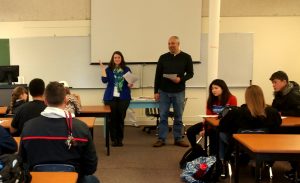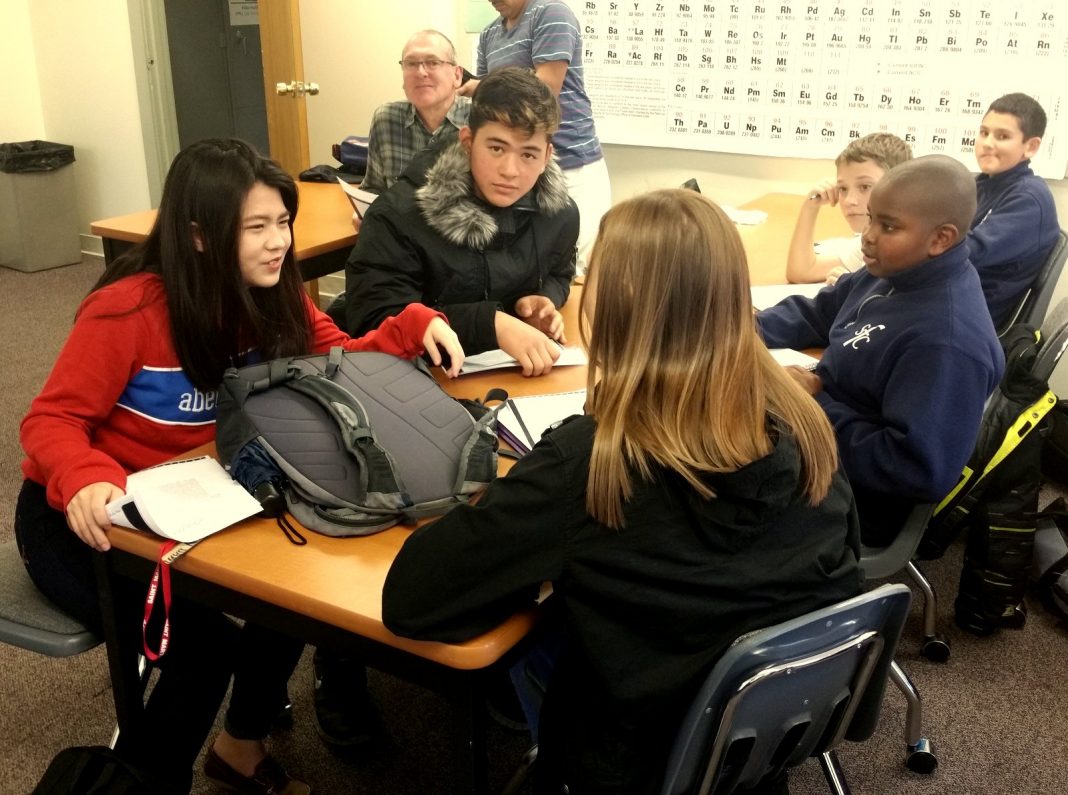The truth, so the saying goes, can set you free. But what happens when it’s taken to an extreme? That was one of the questions weighed by sixth graders from St. Francis Cabrini School in Lakewood during a visit to a college literature class at Saint Martin’s University in October. The students recited from The Liturgy of the Hours alongside Benedictine monks, ate lunch in the cafeteria, and spent an hour with Professor Jeff Birkenstein’s students exploring the Sherwood Anderson short story “The Book of the Grotesque.”

“Maybe you’ll only be able to see your own perspective,” offered one Cabrini student. Others pondered the nature of Truth (capital T) versus truth (small t) and what all of this might have to do with religion or even basic interaction and communication. That was exactly what their teacher Stacy Larson wanted them to do. “We’ve been working on textural evidence, but sixth graders don’t have as much experience being able to speak cooperatively,” she says. “It’s good for them to see how college students communicate effectively as a whole group or as a class.”
Larson has been bringing elementary school students to the campus for the past seven years, although this is her first year with St. Cabrini. A Saint Martin’s alumnus, while a student she co-authored, with Professor Olivia Archibald and others students, One Rule, Many Men: The Monks of Saint Martin’s Abbey, a collection of stories and interviews of the monks of Saint Martin’s Abbey. Exposing her students to a Catholic education at the undergraduate level was one of her goals.

“Most of them have never really seen or experienced what a monk is,” she says. “It’s all foreign to them. I wanted them to understand the distinction between a private Catholic university and a public college. It’s that idea of educating the whole child, physically, spiritually, and mentally.”
Birkenstein believes such visits serve multiple purposes. “I think about the mission of Saint Martin’s,” he says. “We have a large population of students with low socioeconomic status and a large number who are the first generation in their family to attend college. One of the ways to encourage more people to become more educated is to put them around other educated people. Inviting them in and putting them with other students who have ten years on them, they get to see that these young people are serious about school. You never know what impact that’s going to have. It’s intangible.”
To prepare her students, Larson shared different aspects of college life, including living quarters. “I told them about things I was involved in on campus, like being Homecoming Queen my senior year,” she says. “We talked about what they could expect to see, the process of getting into college, and the idea of goal setting. Some of them didn’t like the idea of living in a dorm. They were shocked by the idea that you share a bathroom and a shower with other people.”
She also taught a two and a half week unit on different forms of prayer, and students practiced saying the Liturgy of the Hours very slowly, the way monks do. “It’s hard to experience that in the classroom,” she says. “We did a trial run of what it would look like.”

For sixth grader Emilio Cooper, that was one of the highlights. “I really enjoyed the experience of praying with the monks and I liked the church,” he says. “In the future, I’ll probably go to mass more.”
The visit gives Saint Martin’s students an opportunity to become mentors. “They really take it on,” says Birkenstein. “They turn into teachers for the day. It’s really neat. All of a sudden my students are put in the role of the senior people in the room at a certain level of education. When we get into small groups, the younger students really look to them for leadership.”
The younger students also rise to the challenge, he notes. “It’s amazing how into it some of the students get, and how good some of their questions are. They come up with things I never would have thought of. It’s pretty exciting.”
For the first part of the period, Birkenstein and Larson broke the class up into small groups to discuss the text, which all had read in advance. Then they came back together for an all-group discussion, with sixth graders often chiming in fearlessly.

One of those voices belonged to Tristan Kaipainen, who says he learned from the experience. “I’m taking away the ability to participate in a college class,” he says. “I’ll use that to help me do more in other classes.” Classmate Eric Kiguru took note of the need to study and be focused in class. “You have to take a lot of notes,” he says. “I’ll try doing the same thing in middle school and high school.”
Two of the students are already starting to map out their own college plans. “I’ve learned about this college, and I want to use that experience when I’m older and go to college. I’ll use it for my studies,” says Emma Pires. For Basal Kamau, the day was about noticing what engaged her. “I’m taking away the process of taking time to decide what I’m going to become when I’m older by looking at what my interests were in this college,” she says.
For more information about Saint Martin’s University, visit www.stmartin.edu or call 360-491-4700.
Sponsored




















































